|
TOA
PAYOH VETS
toapayohvets.com
Date:
29 November, 2012
|
|
Focus: Small
animals - dogs, cats, hamsters, guinea pig, turtle & rabbits. |
|
|
|
Some hamster case studies in 2002 and 2012
Dr Sing Kong Yuen, BVMS
(Glasgow), MRCVS
First written: 23 November 2002
Update:
29 November, 2012
|
 TOA
PAYOH VETS TOA
PAYOH VETS
Be Kind To Pets
Veterinary Education
Project 2010-0129 |
|
|
Today, November 29,
2012, I googled "hamster nose lump Singapore and found the
webpage:
http://www.asiahomes.com/singaporetpvet/misc/0762dwarf_hamster_breast_tumour_Singapore.htm
This webpage (below) was written in November 23, 2002 and
is edited. The internet had existed for around 5 years at
that time.
Ten years had passed
in a flash of lightning. The cases below were seen in
November 2012 and my digital images are much better
quality as I read lots of photo magazines available from
the public libraries to improve my standard of digital
photography so that readers enjoy sharper and better
composed pictures of the pets they love and learn how to
be better care-givers of their dwarf hamsters in
Singapore. I invested in a better camera and lens too. It
takes up a lot of time to produce the digital images for
www.toapayohvets.com.
The images now number more than 6000 pictures of cases I
had seen in my practice. I am trying to produce
audio-videos but this takes even more time and I need to
find the time to learn again the various software.
|
|
2002 |
http://www.asiahomes.com/singaporetpvet/misc/0762dwarf_hamster_breast_tumour_Singapore.htm
2002
Case study: The
hamster dies on the operating table
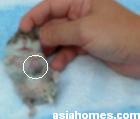 "Just two more 5/0 absorbable interrupted stitches
to close the
gap near the arm-pit." I said to Nurse Ann.
"Hold the fingers of the hamster and abduct the
hand. I mean pull the hand away from the body so that I
can see clearly the bloodied skin and stitch up the gap
near the arm pit."
"Just two more 5/0 absorbable interrupted stitches
to close the
gap near the arm-pit." I said to Nurse Ann.
"Hold the fingers of the hamster and abduct the
hand. I mean pull the hand away from the body so that I
can see clearly the bloodied skin and stitch up the gap
near the arm pit."
This would take less than 60 seconds. The dwarf hamster
moved her hand and wriggled as the fine needle
penetrated her skin. She was feeling the pain as the
effect of the gas anaesthesia had worn off.
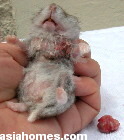
"Let
her sniff more of the gas," I stopped stitching.
Nurse Ann put the cotton-soaked anaesthetic close to the
hamster's nose for a
few seconds. It would be
difficult to stitch a moving dwarf hamster which was
already half the size of an adult palm.
The hamster stopped breathing. There was no movement of
the chest. Careful scrutiny of the hamster is
important as it is not practical to use the ECG
equipment to monitor the heart beat as in human
anaesthesia.
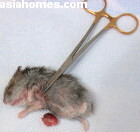 This
hamster had just died under anaesthesia from
cardiovascular failure. It needed oxygen and cardiac
massage immediately. There were none of the electric
machines to stimulate the heart to beat again - those
you would see in the television series ER or 'Emergency
Room'. Even if there were, it was not practical to
apply them on such a small creature. This
hamster had just died under anaesthesia from
cardiovascular failure. It needed oxygen and cardiac
massage immediately. There were none of the electric
machines to stimulate the heart to beat again - those
you would see in the television series ER or 'Emergency
Room'. Even if there were, it was not practical to
apply them on such a small creature.
The first few seconds were critical. The hamster would
be brain dead soon. I pried open its mouth and
blow in air as I massaged its chest to stimulate the
heart. The lungs made a crispy sound as they got
inflated. I blew in air again. It seemed a long time,
but it was probably five seconds. The hamster
looked dead in this suspended time.
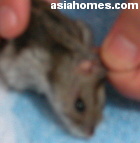 Then
it started to move as it opened its mouth. I quickly
stitched up the gap in the arm pit. The big wart on its
right ear pinnae was cut off. It was weak and I gave it
the electrolyte injection. Then
it started to move as it opened its mouth. I quickly
stitched up the gap in the arm pit. The big wart on its
right ear pinnae was cut off. It was weak and I gave it
the electrolyte injection.
Would it live? The next 3 days would be critical. It was
not in a good condition to operate but there was no
option. The breast lump had become discoloured. The
lower part had become bluish black as it had been
injured when the hamster rubbed against the wood
shavings during movement.
The
next stage would be an open wound. Bacteria would
multiply on this wound and the hamster would lick it
more as the skin became itchy and reddish. Soon, the
hamster would stop eating and die. I could see
that it was dehydrated as I pulled up the skin fold
which stood up high above its neck.
 It was already one and a half years old. "It has
approximately 6 months more of life," I said
to the twin girls who had just completed their Primary
Six School Leaving Examinations. They had pestered their
parents to bring in the hamster for consultation. It was already one and a half years old. "It has
approximately 6 months more of life," I said
to the twin girls who had just completed their Primary
Six School Leaving Examinations. They had pestered their
parents to bring in the hamster for consultation.
"The chances of it surviving anaesthesia are
50:50," I assessed. If only the lump had been
removed earlier when the hamster was stronger and
younger. As hamsters live for around two years, it ages
fast as each month goes by, unlike people who is
expected to live past seventy years.
Well,
the girls had their important PSLE (Primary School
Leaving Examination) examination which would
qualify them to a good secondary school. The mother was
concerned that it would be too upsetting to them if the
hamster had been operated and had died under anaesthesia.
The lump would not shrink and so it was not an abscess.
It was likely a breast tumour. Was it risky to
operate? Yes. The hamster could die on the
operating table.
"How much it would cost?" the father asked.
"Seventy dollars," I said. The cost was a
hundred dollars but then the hamster would be denied the
operation needed. It was irritated by the large mass as
I observed the bluish skin on the lower part of the
rounded tumour. This meant that the hamster had been
licking it and possibly biting the lump to get rid of
it. It must feel clumsy and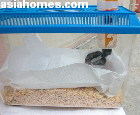 uncomfortable with a big
mass. uncomfortable with a big
mass.
How much would a baby hamster cost? Around ten
dollars. It sure did not make economic sense for most
Singaporean fathers to spend money to get the hamster
operated. Many did it for the love of their children.
To me, it was a risky operation and I would rather not
do it. Death of a creature under anaesthesia is more
traumatic to a veterinarian. A living creature comes to
the clinic and it dies on the operating
table.
This
hamster was revived. It ate a bit five minutes later and
then it went to sleep after a slight half hearted
attempt at cleaning itself. The other hamsters
would be alert and busy grooming themselves after
surgery. This one looked very tired. Well, it is a
nocturnal creature and sleeps during the day.
Would it die in the next few days?
The twins, bespectacled and rather tall loved this
hamster very much and would take good care of it and I
hope it would survive for to live out its normal life
span.
|
|
|
|
|
 Toa
Payoh Vets Toa
Payoh Vets
Clinical Research |
|
|
Copyright ©
Asiahomes
All rights reserved. Revised: November 29, 2012
Toa Payoh Vets
| | |